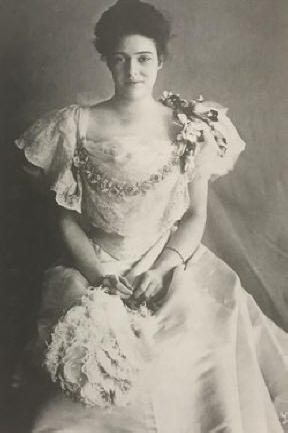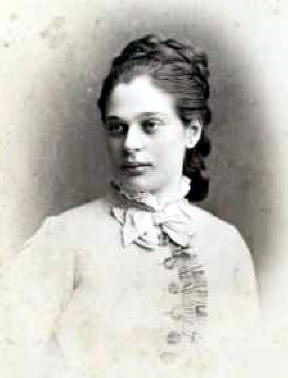|
Collecting Fashion History Historic Fashion Books Links Email |
|
The Bridal
Trousseau
A proper Victorian maiden came
to her marriage bringing love, devotion—and a lifetime’s supply of
lingerie
To the young woman planning her marriage in the 19th century, the trousseau was as important, and possibly more expensive, than the wedding. Describing the trousseau of an upper-class bride in his 1872 exposé, Lights and Shadows of New York, James McCabe wrote “The society woman must have one or two velvet dresses which cannot cost less than $500 each. She must possess thousands of dollars’ worth of laces, in the shape of flounces, to loop up over the skirts of dresses...Walking dresses cost from $50 to $300; ball dresses are frequently imported from Paris at a cost of from $500 to $1,000...[There must be] traveling dresses in black silk, in pongee, in velour, in piqué, [that] range in price from $75 to $175...evening robes in Swiss muslin, robes in linen for the garden and croquet, dresses for horse races and yacht races...dresses for breakfast and for dinner, dresses for receptions and for parties Every item was of the finest-available quality, many pieces entirely handmade and all of them made to order.”

Florence Adele Sloane
Fashion magazines and newspapers regularly recorded the
trousseaux of the era’s most glittering brides; for example, when Florence
Adele Sloane (a Vanderbilt niece) married an English lord in 1895, her
trousseau included duplicate gowns for every imaginable social function and
reputedly cost $40,000.That’s a substantial sum today—but at
the turn of the century, it equaled 70 years’ wages for the average man.

Bettina Rothschild
Miss Sloane’s trousseau paled in comparison to that of
Bettina Rothschild, of the legendary European banking family. According to
fashion journals, it cost 200,000 francs and contained hundreds of items.
Even Mile. Bettina’s parasols were breathtaking (and breathtakingly
expensive). One was covered with rose-colored silk trimmed with ecru gauze
and lace; the tip was encrusted with emeralds and brilliants, the handle
carved out of jade and garnished with other precious gems.

Princess Beatrice
For couture designers, making trousseaux was an important
source of income and prestige. Charles Frederick Worth of Paris was the
first choice of almost everyone who could afford the best; Harper’s Bazar
noted that “there is scarcely a princess married in all of Europe that does
not have a group of Worth toilettes included in her trousseau.” One
exception was Queen Victoria’s youngest daughter, Princess Beatrice; when
she was married in 1885, she ordered her gowns from Redfern, an English
house. Published illustrations of “Gowns from the Trousseau of the Princess
Beatrice” revealed that they were fashionable but restrained; the queen’s
daughter was apparently more comfortable wearing tam o’shanters than tiaras
and more likely to carry an umbrella than a diamond-studded parasol.
Designer houses reveled in the publicity these commissions
brought and made the most of it by displaying their creations publicly.
These displays may seem bizarre to us, but as early as the 1850s, the custom
of showing off trousseaux had become quite acceptable, despite some
lingering adverse opinion. “Have these displays not their danger?” argued
the editor of Les Modes Parisienne. “Should a mother allow her
daughter to see them?” After all, many of the items on show were
undergarments—and heaven only knew what thoughts they might
evoke...Nevertheless, the custom not only continued, but spread to the
United States during the Gilded Age. The French had another
tradition—showing off the corbeille, which was essentially a
luxurious and expensive gift from the bridegroom to the bride. It usually
consisted of jewelry, furs, hand-painted fans, and valuable family
heirlooms. For America’s nouveau riche, displaying the bride’s trousseau and
her gifts was a perfect way to flaunt their freshly-minted fortunes. By the
turn of the century, however, both customs were considered “in strongly
questionable taste.” In 1891, a fashion magazine announced: “The custom of
exhibiting the corbeille and the gifts sent to the bride by her
relatives and friends...has completely fallen into disuse among people of
true refinement...The display of intimate lingerie was painful for the
fiancé and shocking to the modesty of more than one fiancée.”

A corset from 1850.
Whether or not they were ever publicly displayed, most trousseaux were as extensive as finances permitted. In her 1860 volume Ladies' Book of Etiquette, Fashion, & Manual of Politeness, Florence Hartley advised: "In preparing a bridal outfit, it is best to furnish the wardrobe for at least two years in underclothes and one year in dresses, though the bonnet and cloaks suitable for the coming season are all that are necessary, as the fashions…change so rapidly." She later added: "If you are going to travel, have a neat dress and cloak of some plain color, and a close bonnet and veil. Avoid, as intensely vulgar, any display of your position as a bride, whilst traveling."
In 1867, an English magazine suggested a
trousseau should consist of a dozen chemises, nightdresses, and drawers, all
trimmed with lace; half a dozen lace-trimmed camisoles and bests (wool or
flannel undergarments); two French corsets and two crinolines, plus a
"superbly embroidered" special-occasion petticoat. The cost would have been
£100, about $500.
By 1884, prices of ready-made goods had
dropped; a bride would have spent slightly less than half that amount for
this recommended trousseau: a dozen chemises trimmed with embroidery or
insertions, a dozen nightdresses, six well-trimmed combinations, a dozen
drawers, nine trimmed petticoats, one French petticoat, nine camisoles, six
vests, five flannel petticoats, two dressing gowns, three bed jackets, a
dozen pairs of fine-quality Lisle stockings, three pairs of silk stockings,
two dozen handkerchiefs, a pair of French corsets, a bustle, a satin
nightdress and a lace-trimmed sachet. "A modest trousseau might consist of
three dozen of everything," one fashion journal proclaimed, "while a
generous one, each piece of which is usually monogrammed, could be counted
by the gross."
By the end of the century, the focus of the
trousseau-at least for the average bride-has shifted entirely from
fashionable clothing to underclothes, preferably enough to last for the rest
of her life. Girls from poorer families often spent years working on them,
sometimes starting long before a suitable groom appeared on the horizon.
Each item was carefully stitches and stored away in a "hope chest."

Bridal sets from the 1886 Bloomingdale's catalog.
Fashion magazines, too, spent less space
detailing the trousseaux of the wealthy and more on suggestions for the
average bride. One advised her to have "two dozen combinations, that very
homely garment…the smallest number o chemises and kickers should be twelve
dozen each…You cannot do without less than three or four pairs of
corsets…Besides your silk and brocade petticoats you will require about a
dozen in cambric…Two or three dozen nightdresses are not too many…"
Bloomingdale's 1880s mail-order catalogs
offered "Bridal Sets" for women of modest means. They consisted of a
nightgown, corset cover, and drawers, and cost from $2.95 to $6.61,
depending on the trimming. (For $148.79, the bride-to-be could equip herself
with a reception dress, walking dress, suit dress, three day dresses, a
coat, a wrap, a riding habit, two house-dresses, two nightgowns, a shawl,
three petticoats, two chemises, three pairs of drawers, four handkerchiefs,
two corsets, two dozen pairs of plain stockings-as well as a tablecloth and
a set of towels.) By 1908, Sears was selling 12-piece bridal sets for $5.19.
Many practical "modern" young women ignored
even those low-cost fripperies and put their savings into household linens
and kitchen items. In 1905, a writer for Ladies' Home Journal noted
that her trousseau money went for things like a washtub (75 cents),
washboard (40 cents), and, her "chief extravagance," an aluminum tea kettle
and pans ($3.35).
Obviously, this was a much more sensible
approach to the reality of housekeeping-but the excesses of the Victorian
trousseau had a value that went beyond the practical. It was a custom that
gave the young woman an extra moment to linger in her bridal glory. As
The Illustrated American put it: "More concern [centers] around the
paraphernalia of a bride-elect than about the finest frocks worn by
unattached girls or safely settled matrons. From her silk hosiery [to her]
high-heeled white slippers…for the instant every woman is a momentary
heroine.
(c) 2005, 2012. All Right Reserved.
